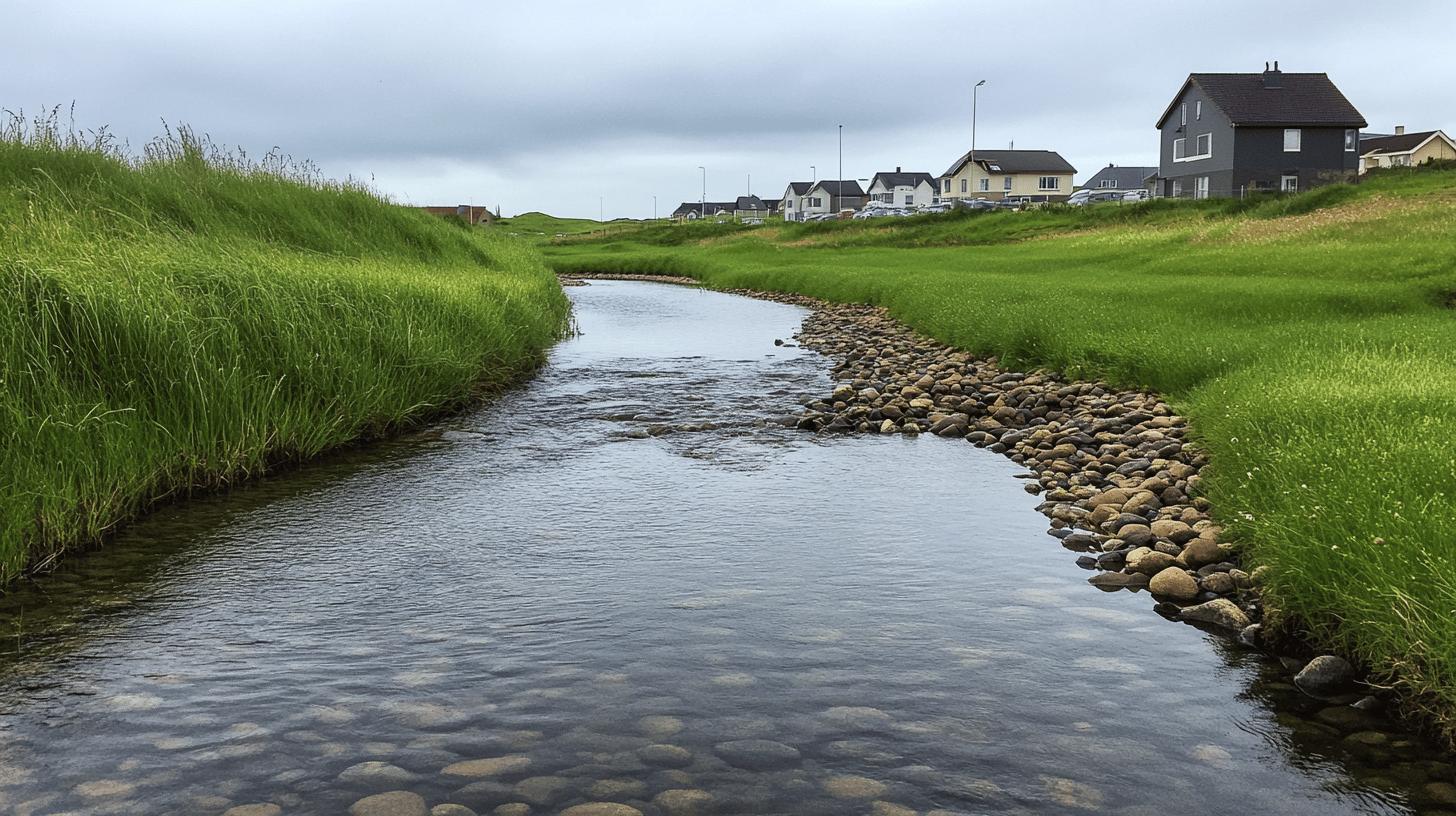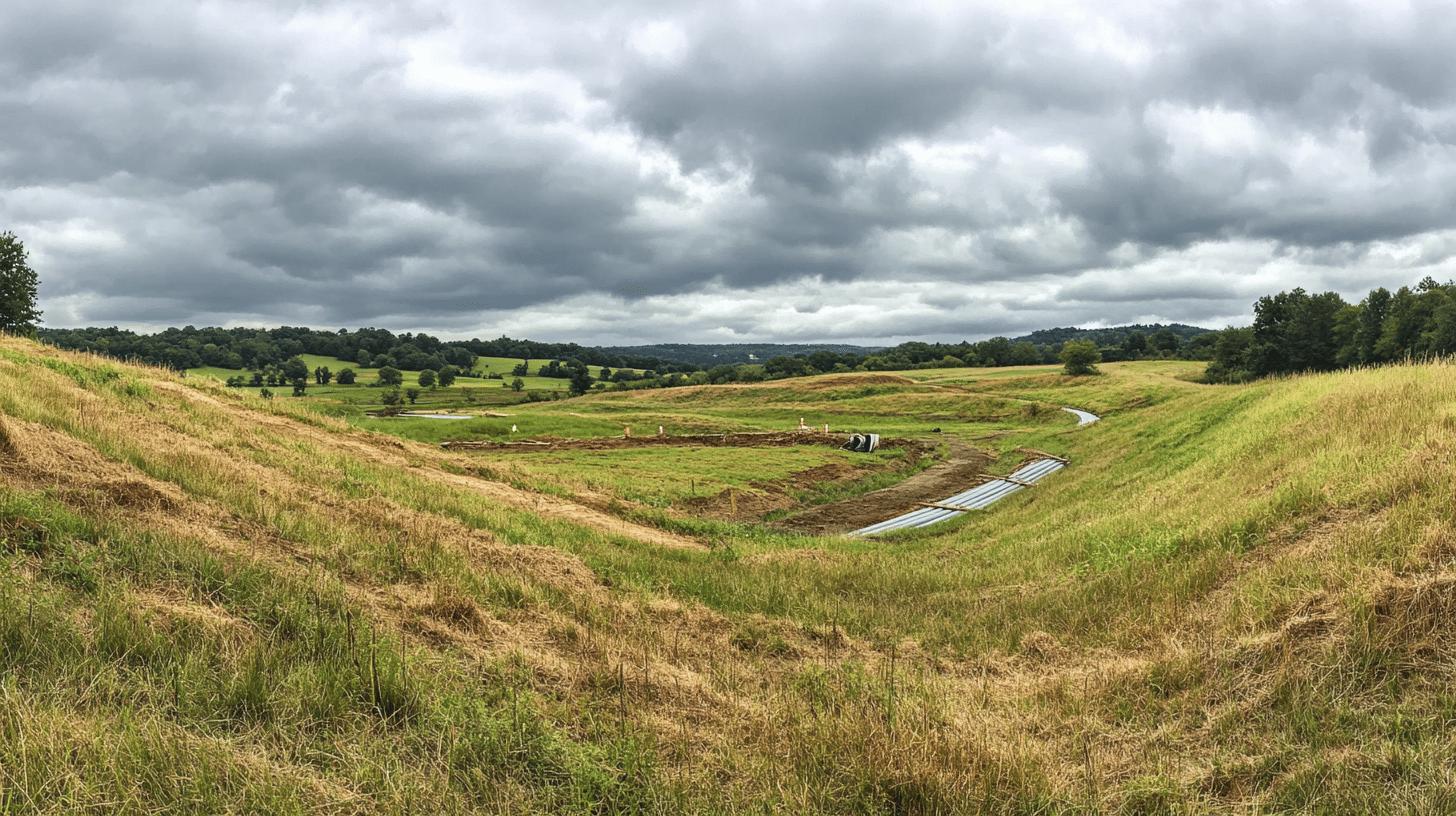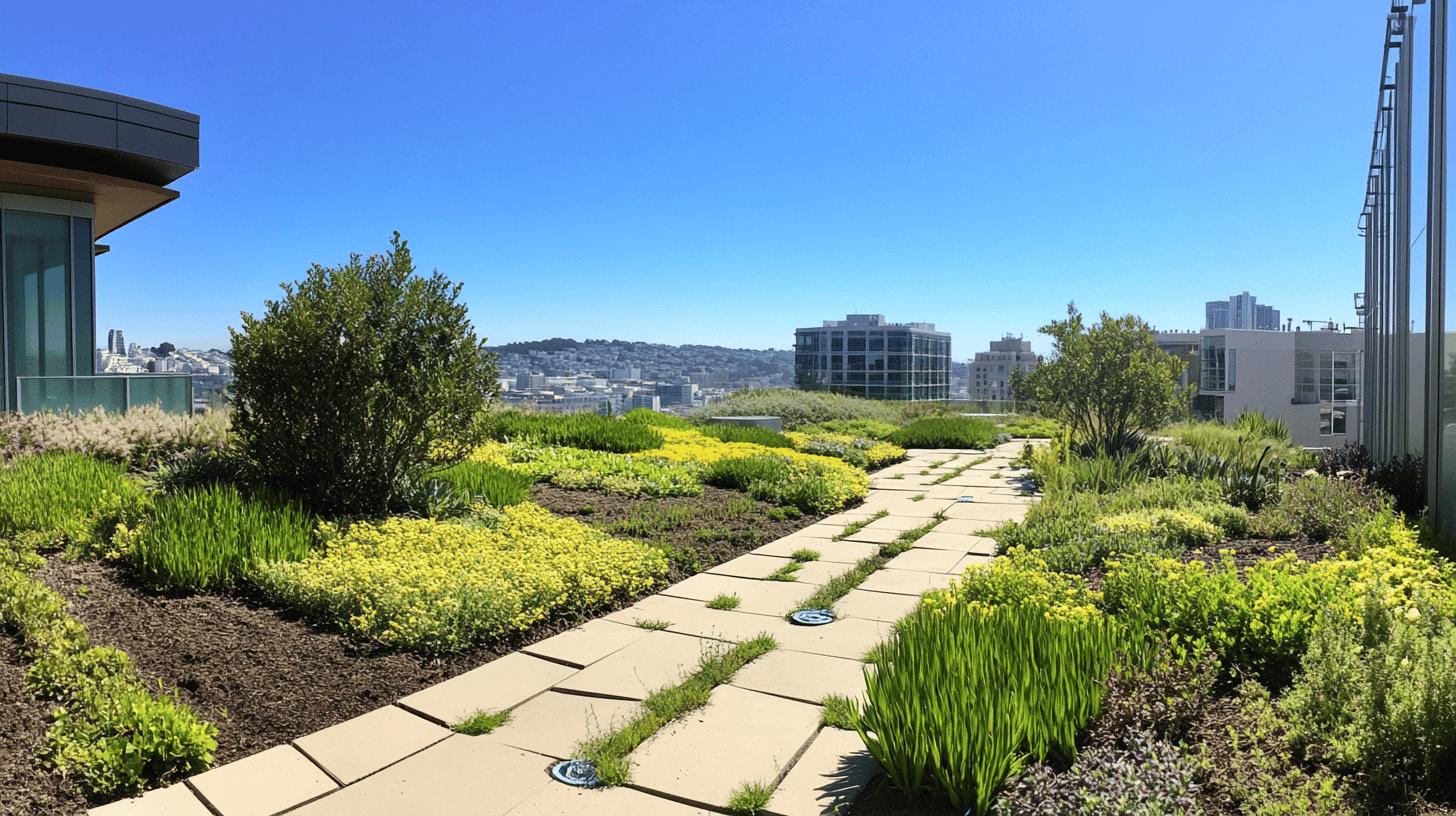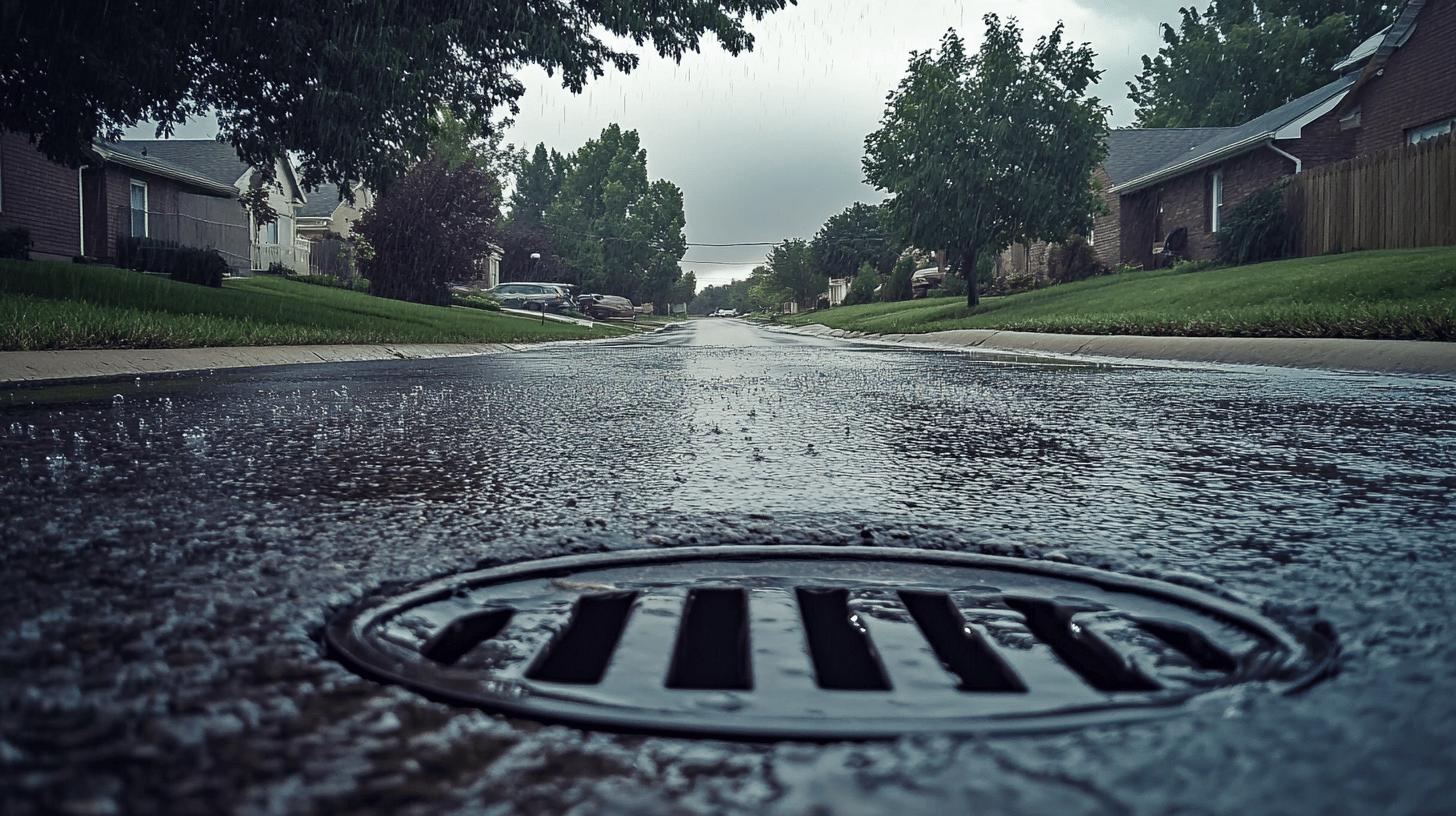TL;DR:
- Key Elements of Drainage Systems:
- Pipes: Transports water.
- Drains: Collect water from surfaces.
- Gutters: Direct rainwater to downspouts.
- Catch Basins: Filter debris before water enters pipes.
- Types of Systems:
- Surface Drainage: Removes surface water via swales, ditches, culverts.
- Subsurface Drainage: Uses perforated pipes to prevent waterlogging.
- Stormwater Management: Collects and discharges rainfall runoff.
- Design Principles:
- Slope, soil type, and rainfall impact design.
- Maintenance:
- Regular inspections, cleaning of pipes, gutters, and catch basins are essential.
- Advanced Solutions:
- Green roofs, permeable surfaces, with metrics for efficiency.
Are you sure your drainage system has everything it needs? Even small mistakes can cause big problems and expensive repairs. In this article, we’ll go over the 10 basic parts of a good drainage system, like pipes, gutters, drains, and catch basins. You’ll learn what each part does and how they work together to keep your property dry and protected. Knowing these parts is important to keep your drainage system working well, prevent water damage, and make sure everything runs smoothly.
Overview of Drainage System Elements
A drainage system has several important parts that help control water flow. Pipes are the main component, moving water from one area to another. Drains collect water from surfaces like roofs or streets and guide it into the pipes. Gutters, found along roof edges, catch rainwater and direct it to downspouts, keeping water from pooling near the building. Catch basins act as filters, trapping debris while letting water flow into the pipes.
All these parts work together to manage water effectively. Gutters lead rainwater to downspouts, which send it to the drains. Pipes then carry the water away, reducing the risk of flooding. Catch basins keep things flowing smoothly by preventing clogs from debris. This teamwork keeps the system working efficiently.
Key Components:
- Pipes: Transport water from one location to another.
- Drains: Collect water from surfaces like roofs, streets, and fields.
- Gutters: Direct rainwater from roof edges to downspouts.
- Catch Basins: Trap debris while allowing water to flow into drainage pipes.
All these parts work together to create a complete drainage system that manages water effectively. By capturing, directing, and moving water, the system helps stop flooding, reduces soil erosion, and protects your home’s foundation. Professional plumbers make sure everything is installed right, keeping the system running smoothly and lasting a long time.
Types of Drainage Systems

Knowing the different types of drainage systems is key to managing water properly. Each one has its own features and serves a specific purpose. Let’s look at the three main types: surface drainage, subsurface drainage, and stormwater management systems.
Surface Drainage Systems
Surface drainage systems help move water off the land’s surface. They often use swales, ditches, and culverts. Swales are shallow channels that direct water away from important areas, while ditches are deeper and handle more water. Culverts are pipes or tunnels that let water flow under roads or railways. These features stop water from pooling on the surface, lowering the risk of floods and erosion.
Subsurface Drainage Systems
Subsurface drainage systems remove water from the soil using perforated pipes buried underground. These pipes channel water away, preventing waterlogging, soil erosion, and damage to buildings or roads. The holes in the pipes let water in but keep out soil and debris, allowing for long-lasting drainage. This system works well in farms and places with high groundwater levels.
Stormwater Management Systems
Stormwater management systems collect and manage rain runoff in cities. They often use features like lakes, ponds, and swales to store excess water. By capturing and gradually releasing stormwater, these systems help prevent flooding and reduce strain on local waterways. Retention basins and infiltration trenches are engineered solutions that work with natural features to handle stormwater efficiently.
| Type of System | Function |
|——————————-|———————————————————————-|
| Surface Drainage Systems | Remove water from the land’s surface using swales, ditches, and culverts. |
| Subsurface Drainage Systems | Remove water from the soil using perforated pipes to prevent waterlogging and erosion. |
| Stormwater Management Systems | Collect and discharge rainfall runoff from urban areas using lakes, ponds, and swales. |
Essential Components of a Drainage System
Pipes are the heart of any drainage system, moving water from one spot to another. They come in materials like PVC, copper, or steel, and need to be strong and installed right to keep water flowing smoothly. Without good pipes, water could cause flooding or damage.
Drains and gutters are key in catching and directing water. Drains pull water from roofs, streets, and fields into the system, while gutters, installed along roof edges, guide rainwater to downspouts. This stops water from pooling around buildings and causing damage.
Catch basins are like filters, keeping debris out of the pipes. They’re placed in spots where water gathers, like near street corners or under downspouts, and help trap things like leaves and trash. By keeping debris out, catch basins prevent clogs and keep the drainage system working well.
Key Components:
- Pipes: Transport water from one location to another.
- Drains: Collect water from surfaces like roofs, streets, and fields.
- Gutters: Direct rainwater from roof edges to downspouts.
- Catch Basins: Trap debris while allowing water to flow into drainage pipes.
Design Principles of Drainage Systems

Designing a good drainage system is key to preventing flooding, soil erosion, and property damage. It involves considering factors like the land’s slope, soil type, and expected rainfall to effectively direct water away from important areas.
The slope of the land is crucial. A well-designed system uses natural slopes with features like perforated pipes to keep water flowing smoothly and swales to guide water away and prevent erosion.
Hiring professional plumbers ensures your drainage system is designed and installed correctly, making it both effective and long-lasting.
Design Considerations:
- Slope: Ensures efficient water flow by using the land’s natural gradient.
- Soil Type: Determines the permeability and drainage capacity.
- Rainfall: Expected precipitation levels influence design capacity.
- Perforated Pipes: Allow water to enter the system while filtering out debris.
- Swales: Shallow channels guide surface water away to prevent erosion.
Installation and Maintenance of Drainage Systems
Installing and taking care of your drainage system is super important for it to work well. There are two main ways to install these systems: trenching and trenchless methods. Trenching means digging a hole to lay the pipes, while trenchless techniques, like pipe bursting or directional drilling, let you install pipes without tearing up the surface too much. This is great for busy areas where digging can cause a lot of disruption.
Regular maintenance is key to keeping your drainage system running smoothly. If you don’t check and clean it regularly, blockages can happen, leading to water backup and damage. Maintenance tasks include inspecting and cleaning pipes, making sure catch basins are clear of debris, and checking that gutters and downspouts aren’t clogged. By staying on top of these tasks, you can catch small problems before they turn into big ones.
Maintenance Tasks:
- Inspecting pipes: Regularly check for blockages and damage.
- Cleaning gutters: Ensure gutters and downspouts are debris-free.
- Maintaining catch basins: Remove leaves, trash, and sediment.
- Checking for leaks: Inspect joints and connections for water leakage.
- Clearing drains: Remove obstructions in surface and subsurface drains.
- Testing for proper water flow: Ensure water flows freely throughout the system.
Hiring professional plumbers for your drainage system installation and maintenance comes with big advantages. They know exactly how to install the system correctly and use the best methods for your property. Plus, they have the right tools and expertise to keep everything running smoothly, spotting potential issues before they become major problems. By relying on pros, you can make your drainage system last longer and work better.
Advanced Drainage Solutions and Technology

Sustainable drainage systems (SuDS) are paving the way for eco-friendly drainage options. They use things like green roofs and permeable surfaces to naturally manage stormwater. Green roofs soak up rain, which helps reduce runoff and keeps buildings insulated. Permeable surfaces let water seep into the ground, helping recharge groundwater. SuDS not only handle water better but also improve air quality and create green spaces in cities.
Advanced technologies are also changing how we design and manage drainage systems. Tools like drainage performance metrics measure how well a system manages water flow and prevents flooding. Audits help spot areas that need improvement and ensure everything meets regulations. These technologies allow for real-time monitoring and adjustments, keeping drainage systems running at their best. Professional plumbers are trained to use these advanced solutions, blending traditional and modern techniques for effective results.
Advanced Solutions:
- Green Roofs: Absorb rainfall and provide insulation.
- Permeable Surfaces: Allow water to infiltrate the ground.
- Drainage Performance Metrics: Measure system efficiency in real-time.
- Drainage Audits: Identify areas for improvement and ensure compliance.
- Real-Time Monitoring: Enable adjustments for peak efficiency.
Final Words
To understand a drainage system, you need to know its key components: pipes, drains, gutters, and catch basins. Each part plays a role in managing water and preventing flooding.
Different types of drainage systems, like surface and subsurface drainage, serve specific purposes in controlling water flow. Important design factors, such as land slope and soil type, ensure the system works well.
Proper installation and regular maintenance are crucial for keeping everything efficient. Using advanced technologies and eco-friendly solutions can make the system more sustainable. By focusing on these elements, you can have a reliable and modern drainage system.
FAQ
What are the basic components of a drainage system?
A drainage system includes pipes, drains, gutters, and catch basins. Pipes transport water, drains collect water from surfaces, gutters direct rainwater to downspouts, and catch basins filter debris while allowing water flow.
What does a drainage system include?
A drainage system includes pipes, drains, gutters, and catch basins. These components work together to transport and manage water flow, preventing flooding and water damage.
What are the different elements of a drainage plan?
The elements of a drainage plan involve analyzing land slope, soil type, and expected rainfall. It includes designing the layout of pipes, gutters, drains, and catch basins.
What are the types of house drainage systems?
Types of house drainage systems include surface drainage systems, subsurface drainage systems, and stormwater management systems.
What are the 4 characteristics of a drainage system?
A drainage system must efficiently manage water flow, prevent waterlogging, filter debris, and adapt to land slope and rainfall patterns.
What should I do if my house drainage system is clogged?
If your house drainage system is clogged, try using a plunger or drain snake. If the blockage persists, contact a professional plumber for an assessment and repair.

